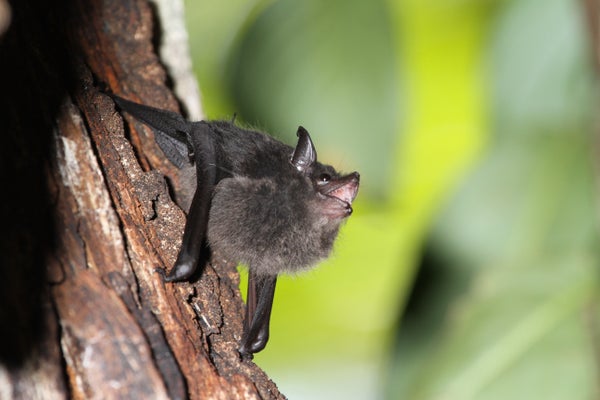Mark Stratton: This is Scientific American’s 60-Second Science. I’m Mark Stratton.
It was lights out, and the babies were up—again. Ahana Fernandez of the Natural History Museum, Berlin, pointed her microphone at the day roost. She was trying to catch these bat pups in full babble mode.
[CLIP: Babbling bat recording]
On supporting science journalism
If you're enjoying this article, consider supporting our award-winning journalism by subscribing. By purchasing a subscription you are helping to ensure the future of impactful stories about the discoveries and ideas shaping our world today.
Now, normally, when we think of babbling babies, we’re talking human newborns. But Fernandez was in the forest to prove something surprising: that these bat babies babble in many of the same ways humans do despite a wide evolutionary gap between us and them.
Fernandez: Babbling is a production milestone in human infant speech development and it is characterized by universal features. However, evidence for babbling in nonhuman mammals is scarce, rendering cross-species comparisons difficult. We investigated the pup babbling behavior of wild Saccopteryx bilineata, a bat capable of vocal imitation to compare its features to those that characterize human infant babbling.
Stratton: The findings are published in the journal Science. [Ahana A. Fernandez et al., Babbling in a vocal learning bat resembles human infant babbling]
The sac-winged bat is known to be particularly loquacious, with a repertoire of 25 different syllable types.
Fernandez has been studying the species for six years. In previous work on their language, she and her colleagues noticed that sometimes mother spoke in a kind of pattern meant to get a response from their pups. She calls it “motherese”: basically, a kind of baby talk aimed at their pups to guide them toward adult bat language.
If you’ve ever been in front of a four-month-old, you yourself have probably uttered or heard someone speak in baby talk. Bat mothers, it turns out, do the same.
Fernandez showed that these female sac-winged bats heighten the pitch of their timbre and slow down their tempo to enable the pups to engage.
In this current research, after studying 20 of these babbling babies in Costa Rica and Panama, the researchers identified eight speech precursors, or protophones, in the pups’ babbling. Each of the eight share a parallel to that of human infants:
One: baby bat babbling starts early in life.
Two: Bouts of babbling contain combinations of adultlike sounds mixed with total gibberish.
Three: Bat babies learn a smaller set of sounds that are universal to adult bat speak.
Four: Eventually, adult bat words, our syllables, emerge from the babble.
Five: The babies repeat the heck out of those adult bat word sounds. Think of a human baby saying, “Ba ba ba, ga ga ga”—over and over again.
Six: These repeated “syllable trains” get a rhythm—so bat babies squeak to a beat.
Seven: Babies will happily talk to themselves—it only takes one for conversation in bat babble.
And eight: Different colonies of babbling baby bats in Panama and Costa Rica, male and female, all babbled the same way.
A long list of specifics to be sure. But, says Fernandez, the fact that they are all there is really interesting and not just for understanding bat speak.
Fernandez: Human language is a very complex system requiring different cognitive abilities—for example, the ability for vocal imitation. By investigating if, and to what extent, those abilities evolved in other species helps us to better understand the biological foundations of human language. In our case, pup babbling indicates when vocal learning is taking place. This allows us to pinpoint the exact time window in the brain when learning processes are ongoing, enabling us to study the neuromolecular foundations of vocal imitation.
Stratton: And just like in humans, clear communication can make or break a bat’s future. The research team found the first 10 syllables the pups acquired were present in the complex songs that adult males used to stake their territory—all to ensure the birth of more babbling babies.
The research, she says, opens the door to a better understanding of the dynamic relationship of parents and children in humans.
Fernandez: Even though humans and bats are so phylogenetically different, they use a strikingly similar behavior to reach the same goal: acquiring a large and complex vocal repertoire. Both use babbling to master the control of their vocal apparatus, enabling them to produce complex sounds and vocalizations. Studying more different biological species, both vocal learners and nonvocal learners, will help us understand which evolutionary pressures cause babbling to be present in some species and not in others.
Stratton: Regardless of what other corners we may yet find babbling babies, we now know that human and bat parents share something in common. They must both rear loud, gibbering young—often in the dead of night.
Thanks for listening to Scientific American’s 60-Second Science. I’m Mark Stratton.
[The above text is a transcript of this podcast.]

